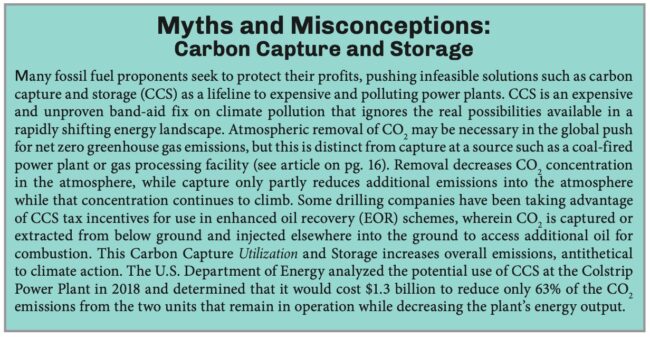
By Nick Fitzmaurice
Previous issues of Down to Earth have explored the concept of the energy transition, which entails decarbonizing local and global energy systems to address the climate crisis. This transition includes numerous interrelated components that must be achieved in combination. Parts one and two of this series addressed electrification and electricity decarbonization. This third installment of Montana’s Energy Transition unpacks efficiencies and load reduction, focusing on demand side management (DSM) as a key component of decarbonizing energy. Look for future installments of Montana’s Energy Transition in subsequent issues of Down to Earth, diving into transmission infrastructure expansion, power sharing across the West, and other pieces of the energy transition!
Efficiencies
 With all else held equal, electrifying energy in Montana could lead to dramatically increased electric loads throughout the energy system. Add to that the projected increase of data centers and cryptocurrency mining operations, and the electrical grid could be strained beyond its designed limits. Whether or not these growing loads are warranted is a different discussion, but the truth of the matter is that today’s build-out rate of carbon-free energy resources may not keep up with current load growth projections. It is therefore essential to pursue DSM and efficiency measures to ensure demand does not exceed generation capacity and to prevent an overbuild of expensive, unnecessary generation infrastructure. Efficiencies seek to achieve the same functional output with a lower energy input, while demand response programs are designed to encourage consumers to alter their level and pattern of electricity use based on the overall load in the system at a given time.
With all else held equal, electrifying energy in Montana could lead to dramatically increased electric loads throughout the energy system. Add to that the projected increase of data centers and cryptocurrency mining operations, and the electrical grid could be strained beyond its designed limits. Whether or not these growing loads are warranted is a different discussion, but the truth of the matter is that today’s build-out rate of carbon-free energy resources may not keep up with current load growth projections. It is therefore essential to pursue DSM and efficiency measures to ensure demand does not exceed generation capacity and to prevent an overbuild of expensive, unnecessary generation infrastructure. Efficiencies seek to achieve the same functional output with a lower energy input, while demand response programs are designed to encourage consumers to alter their level and pattern of electricity use based on the overall load in the system at a given time.
Efficiencies can most accessibly be achieved in homes and businesses by replacing outdated household appliances. At scale, adopting better building energy efficiency codes at the municipal, state, and federal government levels is a long-term solution for implementing deep-rooted efficiencies. Efficiency overlaps with electrification (discussed in Montana’s Energy Transition Part 1) in a number of areas, such as installing highly efficient electric heat pumps and induction stoves. However, the opportunities for efficiency upgrades extend to all electric appliances and beyond. Consider the highest energy guzzlers such as washers and dryers, refrigerators, dishwashers, microwaves, and any other appliances cluttering countertops and cabinets. Newer, highly efficient appliances often improve user experience while using less energy. LED lighting is another accessible efficiency upgrade, greatly mitigating the energy consumption of incandescent and fluorescent bulbs. Energy Star is a nationally recognized certification that can help identify energy-efficient home appliances.
Efficiency can be realized indirectly as well by minimizing the amount of energy a building loses to the surrounding environment. Ensuring proper insulation can passively hold living and working spaces at a comfortable temperature, reducing energy consumption for heating and cooling dramatically and saving money in the process. Replacing old windows with highly insulative multi-pane windows and ensuring that all exterior doors adequately seal with their frames are a couple of great places to start. The federal Inflation Reduction Act (IRA) includes ample rebates and incentives for building energy efficiency improvements, so don’t miss out!
At a more macro level, containing urban sprawl for more walkable and bikeable cities can reduce the energy needed for transportation. Electric vehicles are great, but it is also necessary to move away from car-centric development to reduce energy needs and improve quality of life. Where electric transportation is still necessary, single occupancy vehicles can be limited through the implementation of comprehensive public transportation systems, such as integrating electric bus fleets with electric passenger rail both within and between urban centers.
Load Reduction and Shifting
While efficiency improvements can reduce overall energy consumption, utilities can also pursue DSM through pricing structures that disincentivize expensive electricity use during peak demand periods. Utilities often build capacity infrastructure to meet the most extreme energy needs, but electricity demand varies dramatically both throughout a given day and throughout a given year. For example, a daily peak in demand is experienced in the late afternoon, while seasonal winter and summer demand peaks are experienced on the coldest and hottest days of the year. Instead of building excessive costly infrastructure that only runs to keep the lights on during infrequent extreme peaks and sits dormant the rest of the year, load shifting redistributes these peaks while load reduction shaves down these peaks for a smoother and lower demand curve. From a utility perspective, load shifting can look like time-of-use tariffs or real-time pricing, for which customers face higher electricity rates during peak periods, incentivizing a shift of non-essential consumption habits away from these peaks. Under these structures, smart appliances such as water heaters or electric vehicle chargers could be programmed to respond to utility data, kicking in when electricity prices are at their lowest (generally overnight). Utilities can also implement load reduction by offering curtailment services to non-essential, heavy-use customers such as a cryptocurrency mining operation or industrial manufacturing facility that agree to shut off or dial back their operations during seasonal load-peaking events.

This article was published in the July 2024 issue of Down To Earth.

